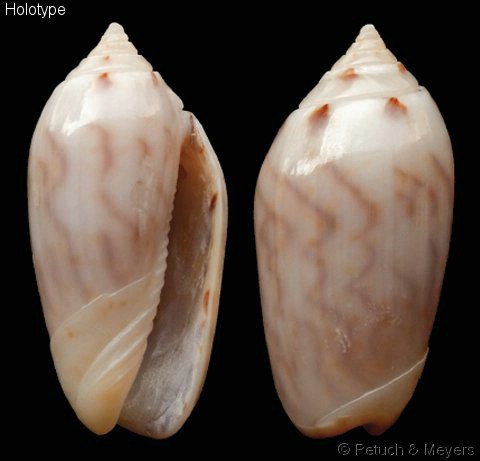 Americoliva mcleani (Petuch &. Myers, 2014)
Americoliva mcleani (Petuch &. Myers, 2014)
Sam 17 Mai 2014 - 10:50
Oliva (Americoliva) mcleani - Petuch, E.J. & R.F. Myers, 2014

Description: Shell small for genus, short, stocky, inflated, with sloping shoulder area; body whorl somewhat pyriform, with widest area anterior of shoulder; spire whorls only slightly elevated, subpyramidal; filament channel very narrow, deep, bounded by sharp carina; spire whorls partially covered by thick callus; fasciole and fascicular band proportionally narrow, confine to anterior one-fourth of body whorl; shell color pale cream-white, overlaid with thin, evenly-spaced pale purple-blue zig-zag flammules that are arranged in zebra pattern; shoulder area devoid of zebra pattern, being uniform pale cream-white in color; edge of filament channel marked with widely-separated dark brown triangular patches, averaging only 6 per whorl; spire whorls and spire calluses pale cream-white in color, marked with widely-separated dark brown patches; columella white, with 13-14 evenly-spaced elongated teeth which become larger and better-developed toward anterior end; posterior one-fourth of columella smooth, devoid of teeth; aperture proportionally wide, becoming wider toward anterior end, pale cream-white on interior; inner edge of lip marked with scattered dark brown irregular flammules; anterior end of fasciole colored pale yellow-orange; protoconch colored pale cream-white, proportionally large, rounded, dome-like, composed of 2 whorls.
Type Specimens: Holotype: length 23 mm, width 11 mm, LACM 3269; Paratypes: 3 specimens, lengths 18 mm, 16 mm, and 12 mm, LACM 3270, same locality and depth as the holotype.
Type Locality: Dredged from 50 m depth off La Libertad, Guayas Province, Ecuador (2 degrees 12.1 minutes S, 80 degrees 55.2 minutes N). The holotype and 3 paratypes were collected by the R/V Velero III (AHF 20-33), 21 January 1933.
Range: At present, known only from deeper water off the coast of Ecuador.
Etymology: Named for Dr. James H. McLean, Curator Emeritus of the Department of Malacology, Los Angeles County Museum of Natural History, in recognition of his innumerable contributions to the systematics and ecology of the mollusks of the Panamic Province.
Discussion: With its distinctive and characteristic zebra color pattern, Americoliva mcleani is most similar in appearance to A. harpularia (Lamarck, 1811) from the southern part of the Gulf of California (see Petuch and Sargent, 1986: 153, plate 30, figure 26; listed as “Oliva (Strephona) venulata color form harpularia”). The deep water Ecuadorian A. mcleani differs from its far northern congener in being a much smaller shell (averaging 21 mm as opposed to the 38 mm length of the harpularia illustrated by Petuch and Sargent), in being more inflated and stocky, in having a clear, unpatterned area around the shoulder and filament channel, in having large dark brown, widely-spaced patches along the filament channel, and in lacking the characteristic large, prominent reddish-brown patch seen on the fasciole of A. harpularia. The Gulf of California and Ecuadorian species also differ in the form of their zebra color patterns; in A. mcleani, the stripes are more numerous and closer together and do not extend onto the shoulder area (having, instead, a wide colorless band), while on A. harpularia, the stripes are fewer in number, far more widely spaced, and extend onto the shoulder and filament channel, where they connect with the small patches that border the filament channel and carina. The similar zebra striped patterns of the two geographically widely-separated species is an artifact of convergent evolution, as no other similarly-patterned olives are known from anywhere between Baja California del Sur, Mexico and Ecuador. In 20-50 m depths off the Ecuadorian coast, Americoliva mcleani is now known to be sympatric with two other endemic Ecuadorian olivids, Americoliva polpasta radix (Petuch and Sargent, 1986) and Strephonella undatella ecuadoriana (Petuch and Sargent, 1986).

Description: Shell small for genus, short, stocky, inflated, with sloping shoulder area; body whorl somewhat pyriform, with widest area anterior of shoulder; spire whorls only slightly elevated, subpyramidal; filament channel very narrow, deep, bounded by sharp carina; spire whorls partially covered by thick callus; fasciole and fascicular band proportionally narrow, confine to anterior one-fourth of body whorl; shell color pale cream-white, overlaid with thin, evenly-spaced pale purple-blue zig-zag flammules that are arranged in zebra pattern; shoulder area devoid of zebra pattern, being uniform pale cream-white in color; edge of filament channel marked with widely-separated dark brown triangular patches, averaging only 6 per whorl; spire whorls and spire calluses pale cream-white in color, marked with widely-separated dark brown patches; columella white, with 13-14 evenly-spaced elongated teeth which become larger and better-developed toward anterior end; posterior one-fourth of columella smooth, devoid of teeth; aperture proportionally wide, becoming wider toward anterior end, pale cream-white on interior; inner edge of lip marked with scattered dark brown irregular flammules; anterior end of fasciole colored pale yellow-orange; protoconch colored pale cream-white, proportionally large, rounded, dome-like, composed of 2 whorls.
Type Specimens: Holotype: length 23 mm, width 11 mm, LACM 3269; Paratypes: 3 specimens, lengths 18 mm, 16 mm, and 12 mm, LACM 3270, same locality and depth as the holotype.
Type Locality: Dredged from 50 m depth off La Libertad, Guayas Province, Ecuador (2 degrees 12.1 minutes S, 80 degrees 55.2 minutes N). The holotype and 3 paratypes were collected by the R/V Velero III (AHF 20-33), 21 January 1933.
Range: At present, known only from deeper water off the coast of Ecuador.
Etymology: Named for Dr. James H. McLean, Curator Emeritus of the Department of Malacology, Los Angeles County Museum of Natural History, in recognition of his innumerable contributions to the systematics and ecology of the mollusks of the Panamic Province.
Discussion: With its distinctive and characteristic zebra color pattern, Americoliva mcleani is most similar in appearance to A. harpularia (Lamarck, 1811) from the southern part of the Gulf of California (see Petuch and Sargent, 1986: 153, plate 30, figure 26; listed as “Oliva (Strephona) venulata color form harpularia”). The deep water Ecuadorian A. mcleani differs from its far northern congener in being a much smaller shell (averaging 21 mm as opposed to the 38 mm length of the harpularia illustrated by Petuch and Sargent), in being more inflated and stocky, in having a clear, unpatterned area around the shoulder and filament channel, in having large dark brown, widely-spaced patches along the filament channel, and in lacking the characteristic large, prominent reddish-brown patch seen on the fasciole of A. harpularia. The Gulf of California and Ecuadorian species also differ in the form of their zebra color patterns; in A. mcleani, the stripes are more numerous and closer together and do not extend onto the shoulder area (having, instead, a wide colorless band), while on A. harpularia, the stripes are fewer in number, far more widely spaced, and extend onto the shoulder and filament channel, where they connect with the small patches that border the filament channel and carina. The similar zebra striped patterns of the two geographically widely-separated species is an artifact of convergent evolution, as no other similarly-patterned olives are known from anywhere between Baja California del Sur, Mexico and Ecuador. In 20-50 m depths off the Ecuadorian coast, Americoliva mcleani is now known to be sympatric with two other endemic Ecuadorian olivids, Americoliva polpasta radix (Petuch and Sargent, 1986) and Strephonella undatella ecuadoriana (Petuch and Sargent, 1986).
_________________
The cure for anything is salt water - sweat, tears, or the sea.
~ Isak Dinesen
 Clem4102Modérateur
Clem4102Modérateur
- Messages : 1935
Date d'inscription : 01/03/2011
Age : 47
Localisation : Corrèze
 Re: Americoliva mcleani (Petuch &. Myers, 2014)
Re: Americoliva mcleani (Petuch &. Myers, 2014)
Lun 26 Mai 2014 - 21:56
voilà une des dernières trouvaille, sympat d'en communiquer l'info Thierry 

Permission de ce forum:
Vous ne pouvez pas répondre aux sujets dans ce forum

